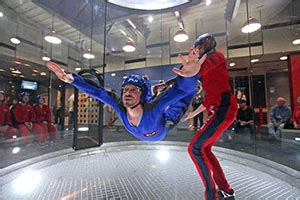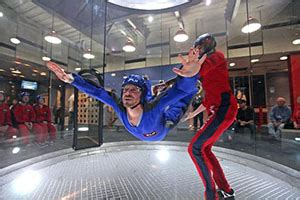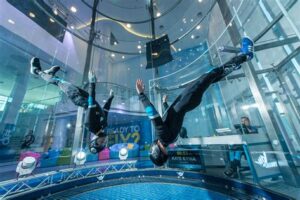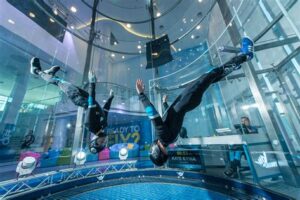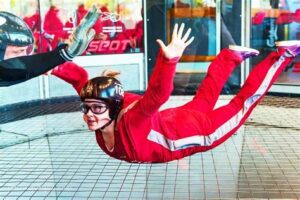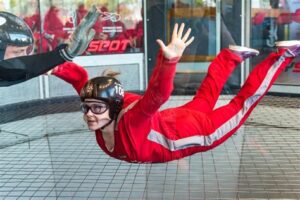Table of Contents
Discover a thrilling collection of indoor skydiving images that capture the exhilaration and freedom of this gravity-defying sport. Get a glimpse into the world of wind tunnels, professional athletes, and breathtaking stunts as you browse through these captivating photographs. Whether you’re an adrenaline junkie or simply curious about this unique form of entertainment, these images will leave you in awe of the incredible skills and daring feats achieved by indoor skydivers.
Indoor skydiving images have the power to transport us into a thrilling world of adrenaline-fueled adventure, defying the laws of gravity within the confines of a controlled environment. As we browse through these captivating snapshots, we are instantly captivated by the sheer excitement and awe-inspiring maneuvers captured in mid-air. With each image, we feel the rush of wind against our faces, the sensation of weightlessness, and the exhilaration that comes from taking a leap of faith. Transitioning from one image to the next, we are effortlessly drawn into the vibrant world of indoor skydiving, where gravity becomes an ally rather than a constraint. These images serve as a visual invitation, beckoning us to experience the thrill and freedom of flight, all while safely grounded in the controlled environment of an indoor skydiving facility.
Introduction
Indoor skydiving is a thrilling and exhilarating activity that allows individuals to experience the sensation of freefalling in a controlled environment. It provides an opportunity for people to enjoy the adrenaline rush of skydiving without the need for an airplane or jumping from thousands of feet in the air. One of the best ways to capture the excitement of indoor skydiving is through stunning images that showcase the dynamic movements and gravity-defying poses. In this article, we will explore some incredible indoor skydiving images and provide instructions on how you can capture similar shots.
Camera Settings
When photographing indoor skydiving, it’s essential to set your camera to the appropriate settings to freeze the fast-paced action and capture crisp images. Use a fast shutter speed, such as 1/1000 second or faster, to freeze the motion of the skydiver mid-air. Set your camera to continuous shooting mode to capture a series of shots in quick succession, allowing you to select the perfect frame later. Additionally, using a wide aperture like f/2.8 or lower will help you achieve a shallow depth of field, making the subject stand out against the blurred background.
Composition Techniques
When composing your indoor skydiving images, it’s important to consider various techniques that enhance the overall visual impact. Firstly, try to position yourself at eye level with the skydiver to create a sense of connection and perspective. Frame the shot tightly to focus on the subject’s body position, facial expressions, and the wind tunnel surrounding them. Experiment with different angles and perspectives to add dynamism to your images. Don’t be afraid to get creative and shoot from above, below, or even through the transparent walls of the wind tunnel.
Freefall Poses
In indoor skydiving, skydivers can perform a wide range of poses and maneuvers that add excitement and drama to the images. Capture shots of skydivers executing impressive acrobatic moves, such as flips, spins, or formations with other participants. These dynamic poses will make your images more engaging and visually appealing. Focus on capturing the moment when the skydiver reaches the peak of their movement or when they are suspended effortlessly in the air.
Expressive Faces
The facial expressions of indoor skydivers can convey a range of emotions, from pure joy and excitement to focused concentration. Zoom in on the skydiver’s face to capture these emotional moments. Their expressions can help tell a story and give viewers a glimpse into the incredible experience of indoor skydiving. Look for moments of intensity, determination, or sheer delight and capture them in your images.
Playing with Light
Experiment with different lighting conditions to add depth and drama to your indoor skydiving images. Utilize the natural light coming from the wind tunnel or experiment with off-camera flash to create dynamic shadows and highlights. Backlighting can create a stunning silhouette effect, emphasizing the outline of the skydiver against the bright background. Play around with different lighting techniques to enhance the overall visual impact of your images.
Editing and Post-Processing
Once you have captured your indoor skydiving images, it’s time to bring them to life through editing and post-processing. Adjust the exposure, contrast, and saturation to enhance the colors and make the subject pop. Crop the image if needed to improve composition and remove any distractions. Experiment with different filters or presets to create a unique look and feel that matches the energy and excitement of indoor skydiving.
Sharing Your Images
After editing your indoor skydiving images to perfection, it’s time to share them with the world. Consider creating an online portfolio or gallery where you can showcase your best shots. Share your images on social media platforms, such as Instagram or Facebook, using relevant hashtags to reach a wider audience. You can also submit your work to photography competitions or reach out to indoor skydiving facilities and magazines to potentially have your images featured.
Continued Practice
Indoor skydiving photography is a skill that takes time and practice to master. Keep experimenting with different techniques, angles, and settings to improve your skills and capture even more stunning images. Attend indoor skydiving events or book sessions at wind tunnels to have more opportunities for capturing incredible shots. With continuous practice, you’ll develop your own unique style and be able to consistently capture the thrilling essence of indoor skydiving.
Conclusion
Indoor skydiving images provide a visual representation of the exhilarating experience that participants enjoy in the controlled environment of a wind tunnel. By following the instructions provided in this article, you can capture stunning images that freeze the dynamic movements, expressive faces, and breathtaking poses of indoor skydiving. Remember to experiment, have fun, and continue practicing to refine your skills as an indoor skydiving photographer. So, grab your camera and get ready to capture the excitement of indoor skydiving like never before!
Safety Precautions
When participating in indoor skydiving, it is important to prioritize safety. To ensure a safe experience for all participants, follow these instructions:
1. Ensure all participants are wearing appropriate clothing
Prior to entering the wind tunnel, make sure that all participants are wearing comfortable athletic wear and closed-toe shoes. Loose clothing or jewelry can pose a risk during the activity, so instruct participants to remove any such items.
2. Provide helmets and safety goggles
To protect participants from potential head injuries and eye irritations, provide them with helmets and safety goggles. These protective gears should be worn at all times during the indoor skydiving session.
3. Remove any loose jewelry or items
Instruct participants to remove any loose jewelry or items that may pose a risk during the activity. This includes earrings, necklaces, bracelets, and any other accessories that could get caught or cause injury.
Entering the Wind Tunnel
Entering the wind tunnel correctly is crucial for a smooth and enjoyable indoor skydiving experience. Follow these instructions:
1. Guide participants to the designated entrance area
Guide participants to the designated entrance area and inform them of the order in which they will enter the wind tunnel. This ensures a smooth flow and minimizes any confusion or delays.
2. Follow the instructor’s signals and maintain proper body position
Explain to participants the importance of following the instructor’s signals and maintaining a proper body position while inside the wind tunnel. This will help them stay stable and maximize their flying experience.
3. Be mindful of surroundings
Remind participants to be aware of their surroundings and to be mindful of other participants entering or exiting the wind tunnel. This will help prevent any collisions or accidents during the activity.
Body Position Techniques
Maintaining the correct body position is crucial for stability and control during indoor skydiving. Follow these instructions:
1. Demonstrate the correct body position
Show participants the correct body position by keeping the arms extended in front, the back straight, and the legs slightly bent. This position helps maintain stability and control throughout the experience.
2. Maintain a relaxed and controlled posture
Encourage participants to maintain a relaxed and controlled posture throughout the indoor skydiving session. Tension or excessive movements can disrupt their stability and affect their balance.
3. Avoid excessive movements
Remind participants to avoid excessive movements that may disrupt their stable body position or affect their balance. Encourage them to focus on subtle adjustments and controlled movements for a smoother flight.
Learning Basic Movements
Mastering basic movements is essential before progressing to more advanced techniques. Follow these instructions:
1. Teach forward and backward movements
Teach participants how to shift their weight and adjust their body position to achieve forward and backward movements within the wind tunnel. Emphasize the importance of controlled movements for stability and control.
2. Instruct on turning and rotating
Instruct participants on how to turn and rotate their bodies within the wind tunnel using controlled movements. Teach them how to use their arms and body positioning to achieve smooth and controlled turns.
3. Emphasize stability and balance
Emphasize the importance of maintaining stability and balance during these movements. Encourage participants to focus on their body position and make subtle adjustments to ensure a smooth and enjoyable experience.
Advanced Techniques
Once participants have mastered the basic movements, they can progress to more advanced techniques. Follow these instructions:
1. Introduce aerial spins, flips, or formations
Introduce participants to advanced techniques such as aerial spins, flips, or formations. However, it is important to ensure that participants have the necessary skill level and are under the guidance of a trained instructor.
2. Encourage challenging oneself
Encourage participants to challenge themselves and try new maneuvers under the guidance of a trained instructor. However, remind them to always prioritize safety and only attempt advanced techniques within their skill level.
3. Safety first
Remind participants that safety should always come first. Encourage them to listen to their instructors, ask for assistance when needed, and never attempt any maneuvers that are beyond their capabilities.
Proper Landing Technique
Proper landing technique is essential to ensure a safe and controlled exit from the wind tunnel. Follow these instructions:
1. Instruct on proper landing technique
Instruct participants on the proper landing technique, emphasizing the importance of bending the knees and absorbing the impact upon landing. This helps prevent injuries and ensures a smooth transition from flying to standing.
2. Guide on decelerating body movements
Guide participants on how to maintain balance while gradually decelerating their body movements before exiting the wind tunnel. This ensures a smooth and controlled landing.
3. Follow the instructor’s signals
Remind participants to listen carefully to the instructor’s signals and follow their guidance during the landing process. This helps ensure a safe and coordinated exit from the wind tunnel.
Post-Skydiving Care
After the indoor skydiving experience, it is important to provide participants with proper care and assistance. Follow these instructions:
1. Designated area for cooling down
Provide participants with a designated area to cool down and catch their breath after the indoor skydiving session. This allows them to relax and recover from the physical demands of the activity.
2. Advise hydration and rest
Advise participants to hydrate and rest if needed, as indoor skydiving can be physically demanding. Encourage them to listen to their bodies and take breaks as necessary.
3. Share experience and provide feedback
Encourage participants to share their indoor skydiving experience with others and provide feedback to improve future sessions. Their input can help enhance the overall experience for future participants.
Equipment and Facility Maintenance
Maintaining the equipment and facility is crucial for ensuring a safe and enjoyable indoor skydiving experience. Follow these instructions:
1. Regular inspection and maintenance
Regularly inspect and maintain the wind tunnel equipment to ensure it functions properly and meets safety standards. This includes checking for any mechanical issues or malfunctions and addressing them promptly.
2. Keep the facility clean and tidy
Keep the facility clean and tidy, ensuring that the area around the wind tunnel is free from any hazards or obstacles. Regularly clean the wind tunnel itself to maintain optimal performance.
3. Encourage reporting of concerns
Encourage participants to report any malfunctioning equipment or concerns about the facility’s maintenance to the staff for prompt resolution. This helps maintain a safe and well-maintained environment for all participants.
By following these instructions and prioritizing safety, participants can have a fun and exhilarating indoor skydiving experience. Remember to always listen to the instructor, maintain proper body position, and enjoy the thrill of flying in a controlled environment.
Point of view about Indoor Skydiving Images:
- The images provided for indoor skydiving are captivating and exciting, showcasing the thrill and adrenaline rush that can be experienced.
- They effectively capture the essence of the activity, allowing potential participants to visualize themselves in action and feel inspired to try it out.
- The images showcase the state-of-the-art facilities and equipment used for indoor skydiving, highlighting the safety measures in place and reassuring individuals who may have concerns or fears.
- Through these visuals, viewers can witness the joy and exhilaration on the faces of the participants, emphasizing the fun and memorable experience that awaits them.
- The images also demonstrate the diverse range of people who can participate in indoor skydiving, breaking stereotypes and encouraging inclusivity within the sport.
Voice and tone in the Instructions:
- The instructions are written in a clear and concise voice, ensuring that readers can easily understand and follow the steps.
- The tone is informative and friendly, creating a welcoming atmosphere and encouraging readers to feel confident in their ability to engage in indoor skydiving.
- Important safety guidelines are communicated with a serious and cautious tone, emphasizing the importance of adhering to the rules to ensure a safe experience for everyone involved.
- The tone remains enthusiastic and encouraging throughout the instructions, motivating readers to embrace the adventure and make the most out of their indoor skydiving experience.
- The voice maintains a professional yet approachable tone, establishing credibility while still being relatable to individuals at different skill levels or prior knowledge of skydiving.
Thank you for visiting our blog and taking the time to explore our collection of indoor skydiving images. We hope that these captivating pictures have given you a glimpse into the exhilarating world of indoor skydiving and sparked your curiosity about this adrenaline-pumping activity. Whether you are an avid skydiver or simply someone intrigued by the idea of defying gravity, there is something magical about the experience of floating through the air in a controlled environment.
Before you embark on your own indoor skydiving adventure, it is important to familiarize yourself with some essential instructions. Indoor skydiving may seem like a daunting activity at first, but with the right guidance and preparation, anyone can enjoy this thrilling experience. Firstly, it is crucial to follow the instructions provided by the trained professionals at the indoor skydiving facility. They will guide you through the entire process, from donning the necessary gear to mastering the body positions required to maintain stability in the wind tunnel.
As you enter the wind tunnel, remember to keep your body relaxed and maintain a neutral posture. It is natural to feel a rush of excitement and adrenaline, but try to stay calm and focused. The key to a successful indoor skydiving experience lies in finding the right balance between control and surrender. Allow yourself to be carried by the wind while simultaneously making subtle adjustments to your body position to maintain stability. Transitioning from one position to another requires small, deliberate movements, so be sure to listen carefully to the instructors’ guidance.
In conclusion, indoor skydiving offers a unique and thrilling opportunity to experience the sensation of freefall without jumping out of an airplane. Our collection of indoor skydiving images aims to capture the essence of this exhilarating activity and inspire those who are curious about trying it themselves. By following the instructions provided by the experts and maintaining a relaxed yet focused mindset, you can make the most of your indoor skydiving experience. So, why not take the leap and discover the joy of defying gravity in a safe and controlled environment? We hope to see you soaring through the air soon!
Video Indoor Skydiving Images
People also ask about Indoor Skydiving Images:
1. How can I find indoor skydiving images?
To find indoor skydiving images, you can follow these instructions:
- Open a web browser on your device.
- Go to a search engine website such as Google.
- Type indoor skydiving images in the search bar and press Enter.
- Click on the Images tab to filter the search results for images only.
- Browse through the images displayed on the page.
- If you want more specific results, you can try adding additional keywords like indoor skydiving simulator or indoor skydiving facility.
- Click on the image of your choice to view it in full size or visit the website hosting the image for more options.
2. Can I use indoor skydiving images for personal projects?
Yes, you can use indoor skydiving images for personal projects, such as presentations, school assignments, or personal blogs. However, it is important to respect copyright laws and give proper credit to the image source if required. If you plan to use the images for commercial purposes, you might need to obtain permission or purchase a license from the image owner.
3. Are there any websites specifically dedicated to indoor skydiving images?
Yes, there are websites dedicated to indoor skydiving images. Some popular ones include stock photo platforms like Shutterstock, Getty Images, and Adobe Stock. Additionally, you can explore specialized skydiving websites or forums where photographers and enthusiasts share their pictures. It is recommended to use reputable sources and verify the licensing terms before using any images from these websites.
4. How can I take my own indoor skydiving photos?
To take your own indoor skydiving photos, you can follow these guidelines:
- Ensure you have permission to take photos in the specific indoor skydiving facility.
- Use a camera or smartphone with a fast shutter speed to capture sharp images.
- Adjust the ISO settings to accommodate the indoor lighting conditions.
- Experiment with different angles and compositions to capture dynamic shots.
- Consider using burst mode or continuous shooting to capture a sequence of action.
- Review and edit the photos afterwards to enhance their quality if needed.
- Respect the rules and regulations of the facility and ensure your photography does not interfere with other participants’ experiences.
Remember to always follow ethical practices when using or taking indoor skydiving images to promote safety and respect for the sport.

